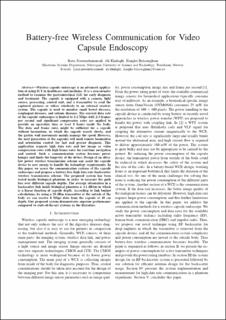| dc.contributor.author | Noormohammadi, Reza | |
| dc.contributor.author | Khaleghi, Ali | |
| dc.contributor.author | Balasingham, Ilangko | |
| dc.date.accessioned | 2020-03-31T08:59:20Z | |
| dc.date.available | 2020-03-31T08:59:20Z | |
| dc.date.created | 2019-08-22T14:02:50Z | |
| dc.date.issued | 2019 | |
| dc.identifier.issn | 2326-828X | |
| dc.identifier.uri | https://hdl.handle.net/11250/2649596 | |
| dc.description.abstract | Wireless capsule endoscopy is an advanced application of using ICT in healthcare and medicine. It is a non-invasive method to examine the gastrointestinal (GI) for early diagnosis and treatment. The capsule is equipped with a camera, light source, processing, control unit, and a transmitter to send the captured pictures or videos wirelessly to an external receiver system. The capsule is used to monitor small bowel diseases, esophageal diseases, and colonic diseases. The current data rate of the capsule endoscopes is limited to 1-2 Mbps with 2-3 frames per second and significant compression rates are applied to provide an operation time at least 8 hours inside the body. The data and frame rates might be sufficient for a capsule without locomotion, in which the capsule travels slowly, and the gastric wall movements mainly manage the speed. However, the next generation of the capsules will need remote locomotion and orientation control for fast and precise diagnosis. This application requests high data rate and low image or video compression rates with high frame rates for real-time navigation and control. Such a communication system becomes power hungry and limits the longevity of the device. Design of an ultra-low power wireless transmission scheme can assist the capsule device to save energy to handle the technology requirements. In this paper, we assess the communication systems of the capsule endoscopes and propose a battery-free high data rate backscatter wireless transmission scheme. The proposed system has been tested inside biological phantom in order to measure the path loss over different capsule depths. The average attenuation in a backscatter link inside biological phantom is 4.1 dB/cm in which is a linear function of capsule depth. According to link budget calculations, by using a 20 dBm transmitter at the outside of the body we can receive 8 Mbps data from the capsule at 10 cm depth. Our proposed system demonstrates superior performance compared to state... | en_US |
| dc.language.iso | eng | en_US |
| dc.publisher | Institute of Electrical and Electronics Engineers (IEEE) | en_US |
| dc.title | Battery-free Wireless Communication for Video Capsule Endoscopy | en_US |
| dc.type | Peer reviewed | en_US |
| dc.type | Journal article | en_US |
| dc.description.version | acceptedVersion | en_US |
| dc.source.volume | 2019-May | en_US |
| dc.source.journal | International Symposium on Medical Information and Communication Technology | en_US |
| dc.identifier.doi | 10.1109/ISMICT.2019.8743718 | |
| dc.identifier.cristin | 1718045 | |
| dc.description.localcode | © 2019 IEEE. Personal use of this material is permitted. Permission from IEEE must be obtained for all other uses, in any current or future media, including reprinting/republishing this material for advertising or promotional purposes, creating new collective works, for resale or redistribution to servers or lists, or reuse of any copyrighted component of this work in other works. | en_US |
| cristin.unitcode | 194,63,35,0 | |
| cristin.unitname | Institutt for elektroniske systemer | |
| cristin.ispublished | true | |
| cristin.fulltext | original | |
| cristin.qualitycode | 1 | |
